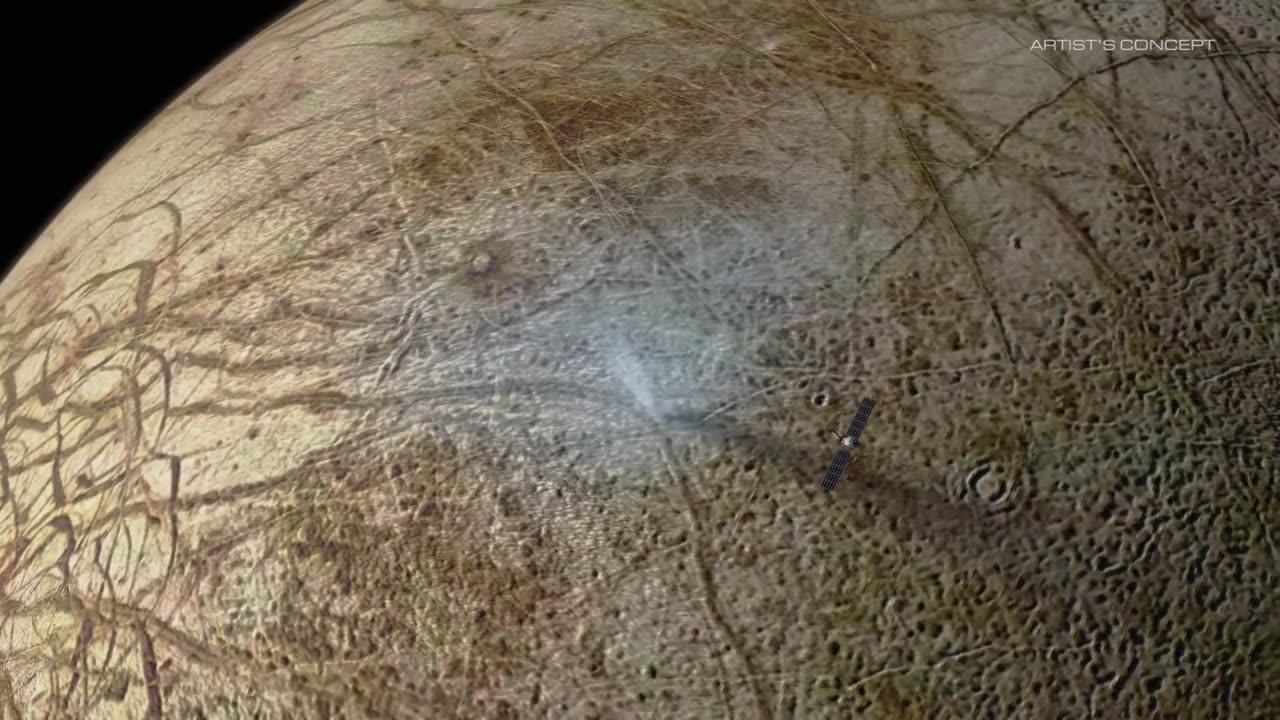Premium Only Content

Why Does NASA Want to Explore Jupiter’s Ocean Moon? (Europa Clipper Science Overview)
#europa #clipper #science #europaclipper #nasa #jupitersocean #nasaexploration #jupiterwater #nasamission #earthwater #europascience #nasascience #spacetechnology #spaceexploration #jupiter #overview #viral #trending #follow #foryou #views #rumblevideo #nasavideos
Why Does NASA Want to Explore Jupiter’s Ocean Moon? (Europa Clipper Science Overview)
Everywhere there’s water on Earth, there’s life. Does that hold true elsewhere in our solar system? NASA’s Europa Clipper mission will investigate Jupiter’s icy moon Europa, which — with its subsurface ocean — is one of the most promising places in our solar system to find environments capable of supporting life.
While Europa Clipper isn’t a life-detection mission, it will be the first to conduct a detailed survey of this icy moon to answer questions about Europa’s potential habitability and composition. The mission’s main goals are to determine the thickness of Europa’s icy shell; confirm the presence of an ocean; investigate the make-up of that ocean; and characterize the geology of the surface. The spacecraft will orbit Jupiter and make approximately 50 flybys of Europa. It’s equipped with a powerful suite of instruments that will work in sync to gather measurements and high-resolution images.
Europa Clipper is expected to launch in October 2024 from NASA’s Kennedy Space Center in Florida. It will arrive at the Jupiter system in 2030.
For more information on the mission go to: https://europa.nasa.gov/.
Credit: NASA/JPL-Caltech/APL
Why Does NASA Want to Explore Jupiter’s Ocean Moon? (Europa Clipper Science Overview)
Everywhere there’s water on Earth, there’s life. Does that hold true elsewhere in our solar system? NASA’s Europa Clipper mission will investigate Jupiter’s icy moon Europa, which — with its subsurface ocean — is one of the most promising places in our solar system to find environments capable of supporting life.
While Europa Clipper isn’t a life-detection mission, it will be the first to conduct a detailed survey of this icy moon to answer questions about Europa’s potential habitability and composition. The mission’s main goals are to determine the thickness of Europa’s icy shell; confirm the presence of an ocean; investigate the make-up of that ocean; and characterize the geology of the surface. The spacecraft will orbit Jupiter and make approximately 50 flybys of Europa. It’s equipped with a powerful suite of instruments that will work in sync to gather measurements and high-resolution images.
Europa Clipper is expected to launch in October 2024 from NASA’s Kennedy Space Center in Florida. It will arrive at the Jupiter system in 2030.
For more information on the mission go to: https://europa.nasa.gov/.
Credit: NASA/JPL-Caltech/APL
Why Does NASA Want to Explore Jupiter’s Ocean Moon? (Europa Clipper Science Overview)
Everywhere there’s water on Earth, there’s life. Does that hold true elsewhere in our solar system? NASA’s Europa Clipper mission will investigate Jupiter’s icy moon Europa, which — with its subsurface ocean — is one of the most promising places in our solar system to find environments capable of supporting life.
While Europa Clipper isn’t a life-detection mission, it will be the first to conduct a detailed survey of this icy moon to answer questions about Europa’s potential habitability and composition. The mission’s main goals are to determine the thickness of Europa’s icy shell; confirm the presence of an ocean; investigate the make-up of that ocean; and characterize the geology of the surface. The spacecraft will orbit Jupiter and make approximately 50 flybys of Europa. It’s equipped with a powerful suite of instruments that will work in sync to gather measurements and high-resolution images.
Europa Clipper is expected to launch in October 2024 from NASA’s Kennedy Space Center in Florida. It will arrive at the Jupiter system in 2030.
For more information on the mission go to: https://europa.nasa.gov/.
Credit: NASA/JPL-Caltech/APL
Why Does NASA Want to Explore Jupiter’s Ocean Moon? (Europa Clipper Science Overview)
Everywhere there’s water on Earth, there’s life. Does that hold true elsewhere in our solar system? NASA’s Europa Clipper mission will investigate Jupiter’s icy moon Europa, which — with its subsurface ocean — is one of the most promising places in our solar system to find environments capable of supporting life.
While Europa Clipper isn’t a life-detection mission, it will be the first to conduct a detailed survey of this icy moon to answer questions about Europa’s potential habitability and composition. The mission’s main goals are to determine the thickness of Europa’s icy shell; confirm the presence of an ocean; investigate the make-up of that ocean; and characterize the geology of the surface. The spacecraft will orbit Jupiter and make approximately 50 flybys of Europa. It’s equipped with a powerful suite of instruments that will work in sync to gather measurements and high-resolution images.
Europa Clipper is expected to launch in October 2024 from NASA’s Kennedy Space Center in Florida. It will arrive at the Jupiter system in 2030.
For more information on the mission go to: https://europa.nasa.gov/.
Credit: NASA/JPL-Caltech/APL
Why Does NASA Want to Explore Jupiter’s Ocean Moon? (Europa Clipper Science Overview)
Everywhere there’s water on Earth, there’s life. Does that hold true elsewhere in our solar system? NASA’s Europa Clipper mission will investigate Jupiter’s icy moon Europa, which — with its subsurface ocean — is one of the most promising places in our solar system to find environments capable of supporting life.
While Europa Clipper isn’t a life-detection mission, it will be the first to conduct a detailed survey of this icy moon to answer questions about Europa’s potential habitability and composition. The mission’s main goals are to determine the thickness of Europa’s icy shell; confirm the presence of an ocean; investigate the make-up of that ocean; and characterize the geology of the surface. The spacecraft will orbit Jupiter and make approximately 50 flybys of Europa. It’s equipped with a powerful suite of instruments that will work in sync to gather measurements and high-resolution images.
Europa Clipper is expected to launch in October 2024 from NASA’s Kennedy Space Center in Florida. It will arrive at the Jupiter system in 2030.
For more information on the mission go to: https://europa.nasa.gov/.
Credit: NASA/JPL-Caltech/APL
Why Does NASA Want to Explore Jupiter’s Ocean Moon? (Europa Clipper Science Overview)
Everywhere there’s water on Earth, there’s life. Does that hold true elsewhere in our solar system? NASA’s Europa Clipper mission will investigate Jupiter’s icy moon Europa, which — with its subsurface ocean — is one of the most promising places in our solar system to find environments capable of supporting life.
While Europa Clipper isn’t a life-detection mission, it will be the first to conduct a detailed survey of this icy moon to answer questions about Europa’s potential habitability and composition. The mission’s main goals are to determine the thickness of Europa’s icy shell; confirm the presence of an ocean; investigate the make-up of that ocean; and characterize the geology of the surface. The spacecraft will orbit Jupiter and make approximately 50 flybys of Europa. It’s equipped with a powerful suite of instruments that will work in sync to gather measurements and high-resolution images.
Europa Clipper is expected to launch in October 2024 from NASA’s Kennedy Space Center in Florida. It will arrive at the Jupiter system in 2030.
For more information on the mission go to: https://europa.nasa.gov/.
Credit: NASA/JPL-Caltech/APL
Why Does NASA Want to Explore Jupiter’s Ocean Moon? (Europa Clipper Science Overview)
Everywhere there’s water on Earth, there’s life. Does that hold true elsewhere in our solar system? NASA’s Europa Clipper mission will investigate Jupiter’s icy moon Europa, which — with its subsurface ocean — is one of the most promising places in our solar system to find environments capable of supporting life.
While Europa Clipper isn’t a life-detection mission, it will be the first to conduct a detailed survey of this icy moon to answer questions about Europa’s potential habitability and composition. The mission’s main goals are to determine the thickness of Europa’s icy shell; confirm the presence of an ocean; investigate the make-up of that ocean; and characterize the geology of the surface. The spacecraft will orbit Jupiter and make approximately 50 flybys of Europa. It’s equipped with a powerful suite of instruments that will work in sync to gather measurements and high-resolution images.
Europa Clipper is expected to launch in October 2024 from NASA’s Kennedy Space Center in Florida. It will arrive at the Jupiter system in 2030.
For more information on the mission go to: https://europa.nasa.gov/.
Credit: NASA/JPL-Caltech/APL
-
 15:34
15:34
Misha Petrov
14 hours agoReacting To TikTok’s Most DELUSIONAL Takes!
18.1K17 -
 1:52:24
1:52:24
Squaring The Circle, A Randall Carlson Podcast
1 day ago#032 Flournoy Holmes' Artwork Helped Define The Southern Rock Phenomenon of The Early 1970's
15.6K3 -
 19:56
19:56
inspirePlay
1 day ago $0.21 earnedWalking with Lions & Facing Africa’s Wild Side | Safari Adventure with the Grid Championship Crew!
8.97K -
 10:50
10:50
RTT: Guns & Gear
1 day ago $0.72 earnedBudget Friendly Carry 2011: EAA Girsan Brat 2311
10.6K3 -
 3:49:06
3:49:06
Alex Zedra
15 hours agoLIVE! New Game | Nuclear Nightmare
102K13 -
 25:08
25:08
MYLUNCHBREAK CHANNEL PAGE
1 day agoUnder The Necropolis - Pt 2
284K64 -
 1:45:59
1:45:59
Spittin' Chiclets
1 day agoCanadian Chokejob - Game Notes Live From Chicago - 12.28.2024
262K32 -
 9:18
9:18
Space Ice
1 day agoThe Guyver - Alien Bug Suits, Exploding Dragons, & Mark Hamill - Weirdest Movie Ever
167K27 -
 9:31
9:31
Silver Dragons
1 day agoSilver Has Failed - Can it Set the Record Next Year? THIS BANK SAYS YES!
4.94K2 -
 7:08
7:08
GBGunsRumble
18 hours agoGBGuns Range Report 28DEC24
2.94K1